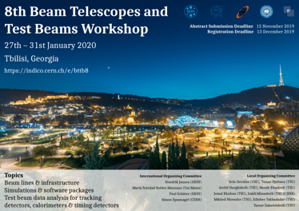Speaker
Description
The R&D challenges of the future CMS High Granularity Calorimeter (HGCAL) necessitate validation with data of the various components, with fully controlled beam quality (in terms of momentum resolution and contamination). For this reason, test beams in the dedicated test-beam area of the H2 beam line of CERN’s North Area took place during the autumn of 2018. Different high-energy hadron and electron beams, were delivered to the HGCAL prototype, with various momenta in the range of 20 – 300 GeV/c. Towards the better understanding of the beam parameters and the key factors affecting it, a detailed, complete simulation study of the H2 beam line, including all the material present in the beam trajectory from the target until the HGCAL module has been developed. The model, developed in the specialized Monte-Carlo code G4beamline, allows the study of virtually all beam characteristics, background, momentum resolution and particle rate. Beam line simulation results implemented to detector simulation. In this study, the simulation results for different electron and pion beams are being presented and compared with test-beam data. Results of the study demonstrate the effect of synchrotron radiation in the definition of the beam momenta in the high-energy range, as well as the energy loss due to Bremsstrahlung due to the beam windows and beam detectors present permanently in the beam line. The model can be used by other users or experiments with similar stringent requirements, towards the better understanding of the beam characteristics present in the CERN North Area beam lines.




